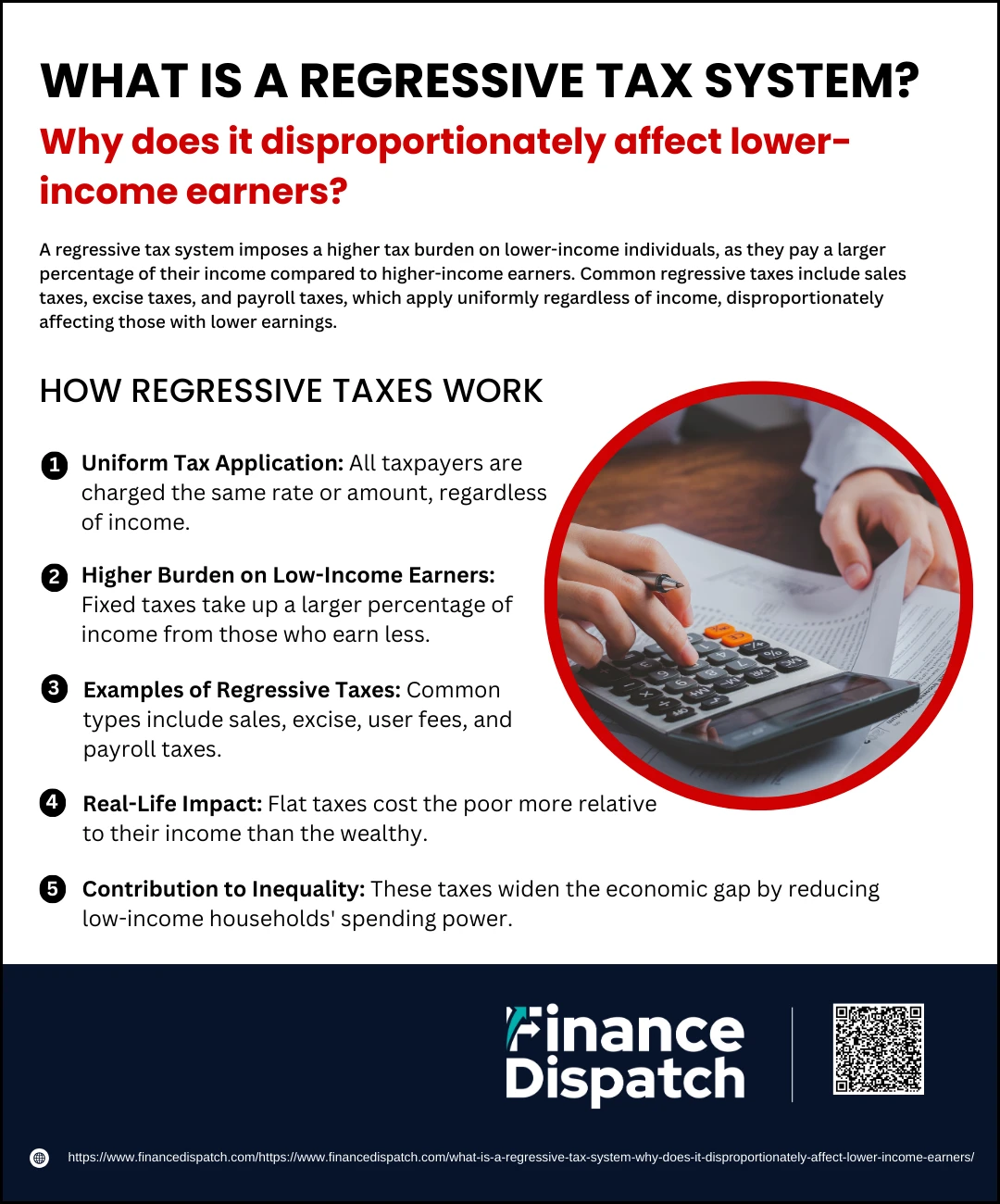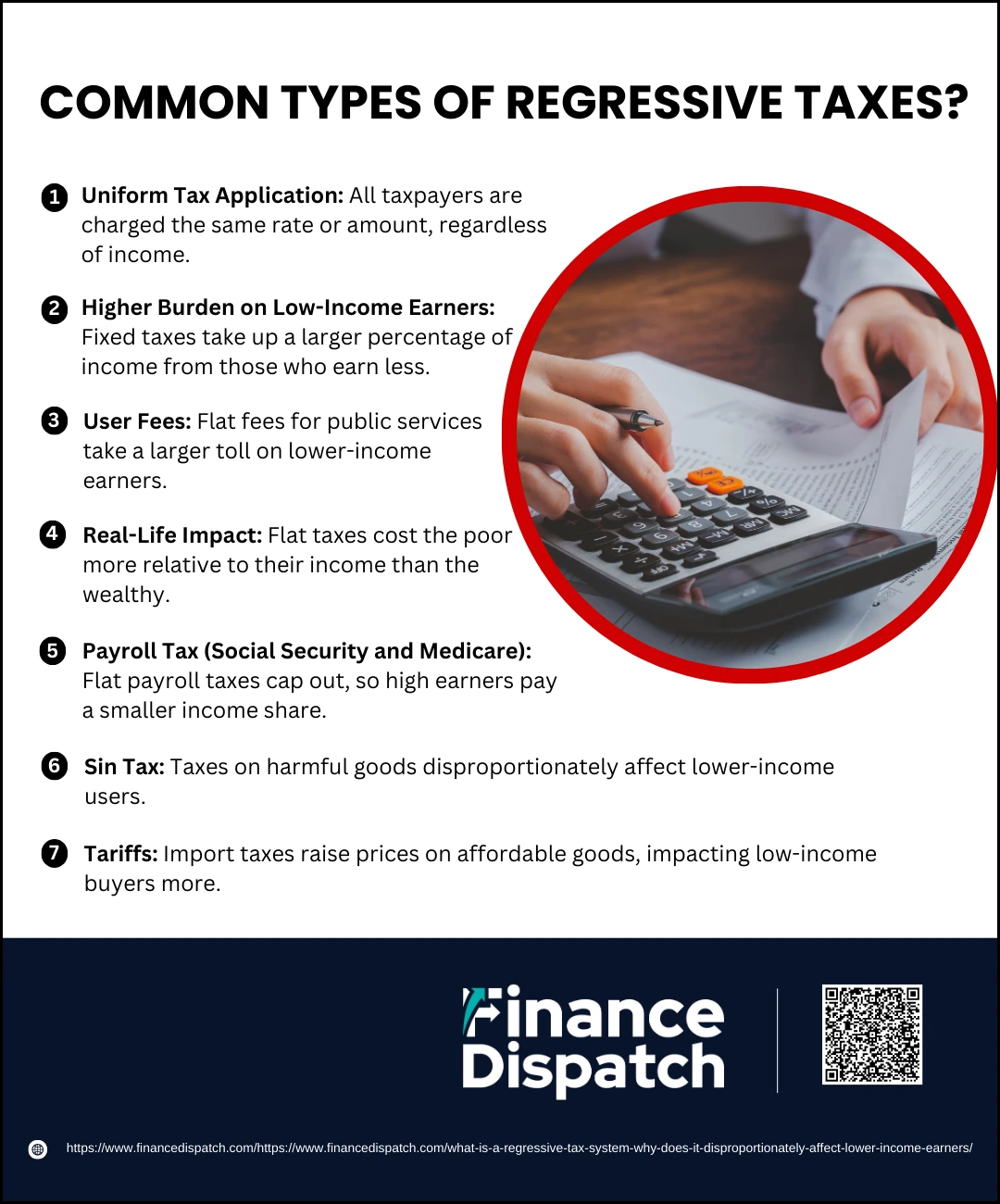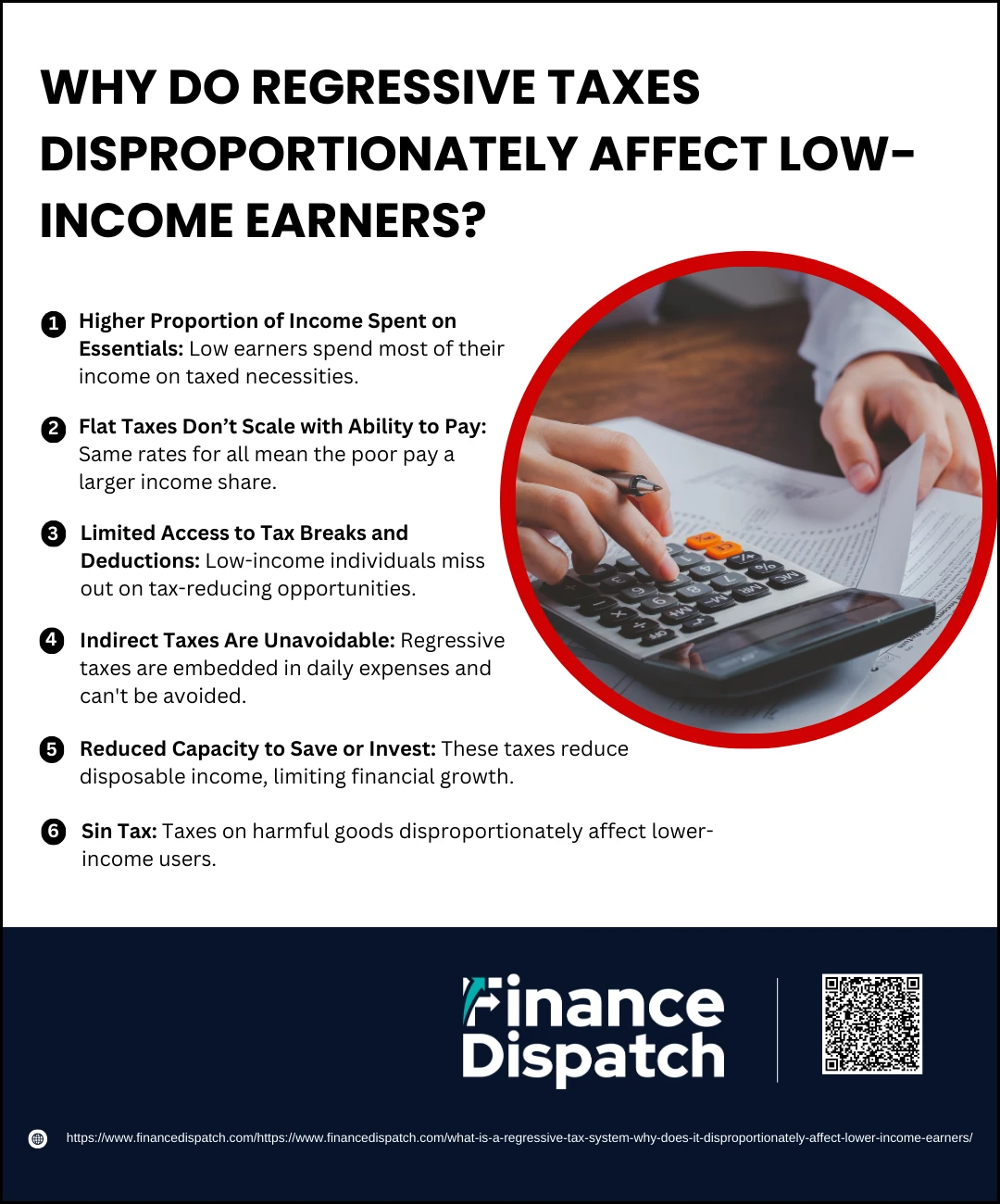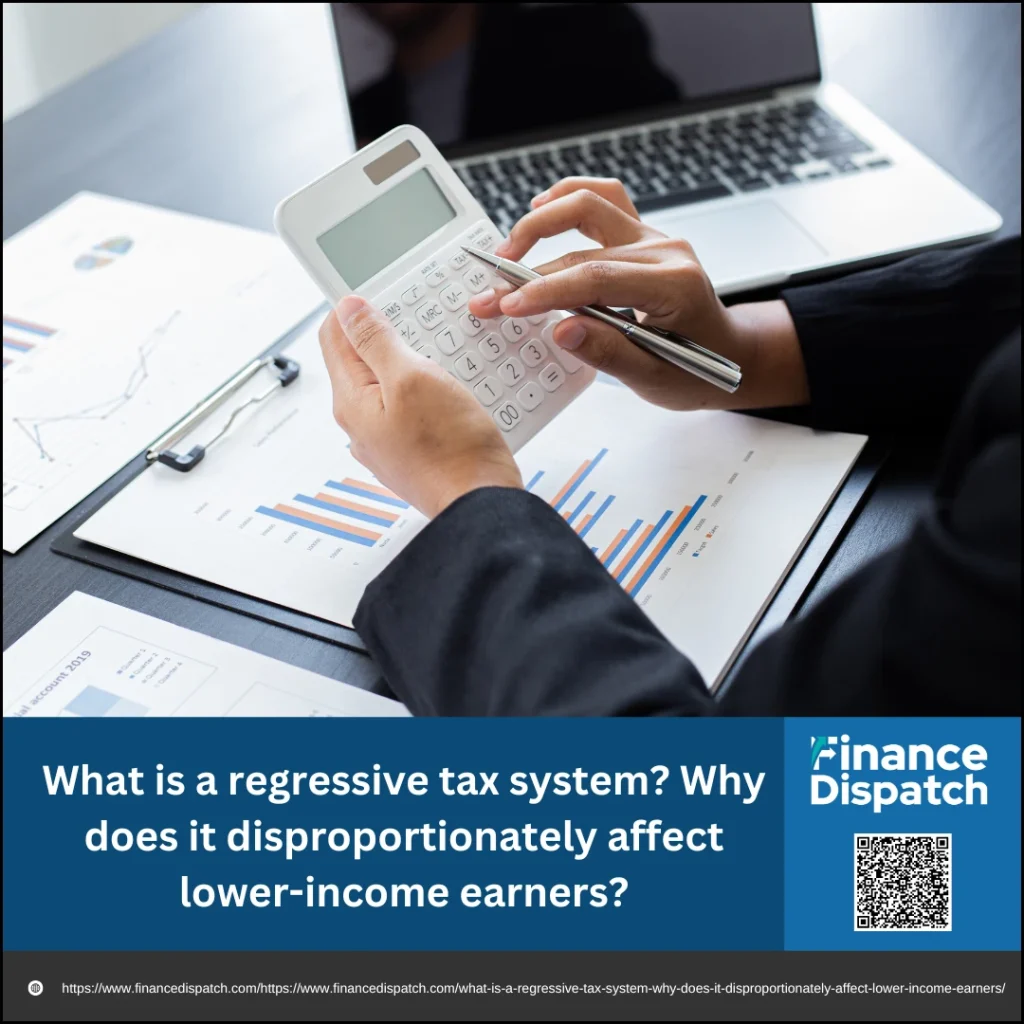Taxation is a fundamental mechanism through which governments fund public services, infrastructure, and social programs. Yet, not all taxes are created equal—some are structured in ways that place a heavier burden on certain segments of the population. One such structure is the regressive tax system. Unlike progressive taxes, where tax rates increase with income, regressive taxes take a larger percentage of income from low-income earners than from those with higher earnings. This imbalance raises critical questions about fairness, equity, and the broader economic impact on society’s most vulnerable groups. In this article, we’ll explore what a regressive tax system is and why it tends to disproportionately affect those who earn the least.
What is a Regressive Tax System?
A regressive tax system is one in which the tax rate effectively decreases as an individual’s income increases. This means that lower-income earners pay a higher proportion of their income in taxes compared to those with higher incomes. Unlike progressive taxes, which are designed to adjust based on a person’s ability to pay, regressive taxes are applied uniformly—regardless of earnings. Common examples include sales taxes, excise duties, and certain user fees. While the actual tax amount might be the same for everyone, it represents a much larger slice of a low-income earner’s budget, making the tax system inherently inequitable. This structure tends to place a disproportionate financial burden on those who are least able to afford it.
 How Regressive Taxes Work
How Regressive Taxes Work
Regressive taxes operate on the principle of uniformity—they apply the same rate or amount to everyone, regardless of income level. At first glance, this may seem like an equal approach to taxation. However, the reality is quite different. Since low-income individuals spend a greater portion of their earnings on essential goods and services, a flat-rate tax on those items ends up consuming a larger share of their income. High-income earners, on the other hand, can absorb these taxes more easily because the taxed amount makes up only a small fraction of their overall wealth. This structural imbalance means that regressive taxes hit lower-income groups harder and deepen the gap between economic classes over time. Here’s how regressive taxes function in real life:
1. Uniform Tax Application
Regressive taxes are imposed at a consistent rate or amount for all taxpayers. Whether someone earns minimum wage or has a six-figure salary, they are taxed the same on specific items or services. This includes things like sales tax on consumer goods or flat toll charges.
2. Higher Burden on Low-Income Earners
Since the tax amount is fixed, it constitutes a larger percentage of income for people who earn less. For example, a $50 tax might be negligible for someone earning $5,000 a month, but significant for someone earning $500.
3. Examples of Regressive Taxes
Some common forms include:
- Sales Taxes on everyday items like food and clothing
- Excise Taxes on gasoline, tobacco, or alcohol
- User Fees such as toll roads, park entry fees, and public service charges
- Flat Payroll Taxes like Social Security contributions up to a capped income
4. Real-Life Impact
Imagine two people buying the same $100 pair of shoes. Both pay a 10% sales tax ($10), but one earns $1,000 a month while the other earns $10,000. For the lower-income person, that tax equals 1% of their income. For the higher-income earner, it’s only 0.1%. The tax burden is heavier for the one who earns less—even though the dollar amount is identical.
5. Contribution to Inequality
Because they reduce the spending power of low-income households more than high-income ones, regressive taxes can worsen income inequality. They leave poorer individuals with less money for savings, healthcare, education, or emergencies—trapping them in cycles of financial hardship. Meanwhile, wealthier individuals experience less impact and continue to grow their assets.
 Common Types of Regressive Taxes
Common Types of Regressive Taxes
Regressive taxes are designed in a way that everyone pays the same rate or amount, regardless of their income level. While this approach may seem fair at first, it often places a heavier financial burden on those who earn less. Because low-income individuals spend a larger proportion of their income on basic goods and services, any tax added to those expenses reduces their financial flexibility. These taxes are often hidden in the cost of everyday necessities, making them especially impactful for those living paycheck to paycheck. Below are the most common types of regressive taxes and how they contribute to income inequality:
1. Sales Tax
Sales tax is one of the most widely used regressive taxes. It is applied uniformly to the purchase of most goods and services. Everyone pays the same percentage at checkout, but low-income households, which spend a larger share of their earnings on essentials, end up dedicating more of their total income to this tax. For example, a 7% tax on groceries impacts a person earning $1,000 a month much more than someone earning $10,000, even though the dollar amount paid is the same.
2. Excise Tax
Excise taxes are specific charges on particular goods such as gasoline, alcohol, tobacco, and sugary drinks. These taxes are typically built into the price of the product, making them less visible but no less burdensome. Since many of these items are commonly consumed across all income groups, lower-income individuals end up paying a higher share of their income to cover these taxes—especially on essentials like fuel.
3. User Fees
Governments charge user fees for access to certain services and facilities like toll roads, public parks, libraries, or processing official documents. While the fees are flat and the same for everyone, they are not adjusted based on income. This means that a $20 toll or entrance fee is more significant to someone earning $1,500 a month than to someone earning $8,000. These costs add up and reduce the ability of low-income individuals to access public resources.
4. Property Tax
Although property taxes are generally based on the value of a property, they can still be regressive in practice. If two homeowners live in similar-value homes but have vastly different incomes, both pay the same tax, even though one may be struggling to meet basic needs. In some cases, retired or fixed-income individuals may also face difficulties paying property taxes despite owning valuable properties.
5. Payroll Tax (Social Security and Medicare)
Payroll taxes are levied at a flat rate on wages up to a certain cap. For example, Social Security tax in the U.S. is 6.2% up to a set income limit. Once a person earns above that cap, their additional income is not taxed. This structure means that low- and middle-income workers’ pay the tax on 100% of their wages, while high earners effectively pay a smaller percentage of their overall income.
6. Sin Tax
Sin taxes are applied to products considered harmful to health or society, such as cigarettes, alcohol, and sugary drinks. These taxes are used to discourage consumption but can have a regressive effect. Studies show that lower-income groups tend to consume these products at higher rates and therefore pay more of their income in sin taxes, further reducing the money they have for essentials.
7. Tariffs
Tariffs are taxes placed on imported goods, which raise the final sale price. As these costs are passed on to consumers, people who rely on more affordable imported products—often lower-income individuals—end up paying more. Since wealthier individuals are more likely to purchase domestic luxury goods, tariffs disproportionately affect those with tighter budgets.
Why Do Governments Use Regressive Taxes?
Despite their disproportionate impact on low-income earners, governments often rely on regressive taxes because they offer practical advantages in terms of simplicity, stability, and political feasibility. Regressive taxes, such as sales tax and excise duties, are relatively easy to implement and collect since they are applied at the point of purchase and don’t require detailed income assessments. This makes them efficient sources of steady revenue, especially in economies with large informal sectors where income-based taxation is difficult to enforce. Additionally, some regressive taxes—like those on tobacco, alcohol, or sugary drinks—are intended to discourage harmful behavior, aligning with public health goals. In many cases, governments also favor these taxes because they tend to provoke less resistance from high-income individuals and corporations compared to income or wealth taxes. While critics argue that regressive taxes deepen inequality, policymakers may view them as necessary trade-offs for funding public services and infrastructure without triggering strong political backlash.
 Why Do Regressive Taxes Disproportionately Affect Low-Income Earners?
Why Do Regressive Taxes Disproportionately Affect Low-Income Earners?
At the core of regressive taxation is a structure that applies the same tax rate or flat fee to everyone, regardless of how much they earn. While this may seem equal in principle, it is not equitable in practice. For individuals with low incomes, these taxes eat into a much larger portion of their monthly budget, leaving less room for savings, investment, or even basic needs. High-income earners, on the other hand, are less affected because the same tax amount represents only a tiny fraction of their wealth. This imbalance means regressive taxes can deepen economic inequality and place an outsized burden on those already facing financial hardship. Here’s a closer look at the reasons behind this disproportionate impact:
1. Higher Proportion of Income Spent on Essentials
Lower-income households often allocate the majority of their earnings toward necessities such as food, housing, transportation, and healthcare. These essentials are frequently subject to sales taxes or excise duties, meaning a large share of their limited income goes directly toward taxed purchases. For wealthier individuals, these same purchases account for only a small part of their overall spending.
2. Flat Taxes Don’t Scale with Ability to Pay
Regressive taxes is not based on income, so they don’t consider an individual’s financial capacity. Whether someone earns $1,000 or $10,000 a month, they may still pay the same toll free, utility charge, or fuel tax. As a result, low-income earners contribute a much higher percentage of their income to these taxes, making them more financially vulnerable.
3. Limited Access to Tax Breaks and Deductions
Wealthier individuals often benefit from tax deductions, credits, or loopholes that allow them to reduce their overall tax liability. In contrast, low-income earners usually don’t qualify for these benefits due to their smaller tax base or lack of access to financial planning resources, making their effective tax rate even higher.
4. Indirect Taxes Are Unavoidable
Many regressive taxes are embedded into the cost of everyday life. Fuel taxes are built into the price at the pump, sales taxes are added at the register, and user fees are mandatory for accessing public services. These taxes can’t be opted out of, which forces lower-income individuals to absorb the burden no matter their financial situation.
5. Reduced Capacity to Save or Invest
After paying regressive taxes on goods and services, many low-income earners are left with little or no disposable income. This limits their ability to save for emergencies, invest in education or retirement, or improve their quality of life—creating a cycle of financial stagnation.
6. Cumulative Effect of Multiple Regressive Taxes
While a single regressive tax might seem minor, the combined impact of multiple taxes—sales tax, fuel tax, property tax, user fees, and payroll taxes—can add up quickly. For low-income households, this layered tax burden can consume a large chunk of their budget, intensifying financial stress and reducing economic mobility.
Comparison: Regressive vs Progressive vs Proportional Taxes
Tax systems around the world are generally structured into three main categories: regressive, progressive, and proportional. Each of these systems determines how the tax burden is distributed among individuals based on their income levels. Regressive taxes place a heavier burden on low-income earners, progressive taxes charge higher rates to those with higher incomes, and proportional taxes apply the same rate to everyone regardless of earnings. Understanding the differences between these tax structures is essential for evaluating their fairness, effectiveness, and social impact. The table below outlines the key distinctions between the three systems:
| Feature | Regressive Tax | Progressive Tax | Proportional Tax |
| Definition | Tax rate decreases as income increases | Tax rate increases as income increases | Same tax rate for all income levels |
| Income Impact | Heavier burden on low-income earners | Heavier burden on high-income earners | Equal rate, varying impact based on income |
| Tax Fairness | Often seen as less equitable | Designed to promote equity | Seen as neutral but can be regressive in effect |
| Examples | Sales tax, excise tax, payroll tax (capped) | Income tax, estate tax | Flat income tax, some state income tax systems |
| Ability to Pay Principle | Not considered | Central to system | Partially considered, but not adjusted by income |
| Economic Effect | Increases income inequality | Aims to reduce income inequality | Can maintain status quo or slightly widen inequality |
| Ease of Administration | Simple to administer | More complex due to income brackets and deductions | Moderately simple, fewer brackets or calculations |
Why Governments Still Use Regressive Taxes
Governments continue to use regressive taxes despite their unequal impact because they offer practical advantages in terms of revenue generation, simplicity, and enforcement. These taxes—such as sales taxes, excise duties, and user fees—are relatively easy to implement and collect, requiring less administrative effort than income-based systems. They provide a steady and predictable stream of income that is less susceptible to economic fluctuations, as people continue to spend on goods and services even during downturns. Additionally, regressive taxes often face less political opposition since they are less visible than direct taxes and affect a wide population equally in amount, not proportion. In some cases, governments also use regressive taxes strategically to influence behavior, such as discouraging the use of tobacco or alcohol through sin taxes. While these taxes raise concerns about fairness, they remain a convenient and efficient tool for funding public services and balancing national budgets.
Real-World Examples of Regressive Taxes
Regressive taxes are present in many countries, often embedded in daily transactions and public services. These taxes apply uniformly but have a greater financial impact on those with lower incomes. While they help governments collect revenue efficiently, they can also deepen economic inequality if not balanced with progressive measures. Below are several real-world examples that illustrate how regressive taxes function across various contexts:
1. Sales Tax in the United States: Most U.S. states impose a sales tax on goods and services, typically ranging from 4% to 10%. Since everyone pays the same rate, low-income households spend a greater share of their income on taxable necessities.
2. Value-Added Tax (VAT) in Europe: Many European countries use VAT, a consumption tax added at each stage of production. With rates as high as 27% (e.g., Hungary), VAT disproportionately affects those who spend a larger portion of their earnings on consumer goods.
3. Fuel Taxes Worldwide: Fuel taxes, such as those on gasoline and diesel, are fixed per unit sold and don’t vary by income. This makes them regressive, as transportation is a basic need that takes up more of a low-income earner’s budget.
4. Excise Taxes on Tobacco and Alcohol: Countries like the U.S., UK, and Australia impose excise taxes on items like cigarettes and alcohol to discourage use. These taxes often hit low-income users harder because the cost forms a larger percentage of their income.
5. Public Transportation and Toll Fees: Flat fees for subways, buses, and toll roads are the same for everyone. While affordable for higher earners, these charges can be significant for those earning minimum wage or relying on public transit daily.
6. Council Tax in the UK: Council tax is based on property bands, not income, meaning two households with vastly different earnings can pay the same amount. This can result in a regressive effect for residents with lower incomes.
7. Social Security Payroll Tax in the U.S.: The Social Security tax is levied at a flat rate on income up to a certain cap (e.g., $168,600 in 2024). Earnings above the cap are not taxed, meaning high-income individuals pay a smaller proportion of their total income.
Strategies to Mitigate Regressive Tax Effects
While regressive taxes are often favored for their simplicity and stable revenue, their disproportionate impact on low-income individuals can worsen inequality. To balance efficiency with fairness, governments and policymakers can adopt targeted strategies to reduce the burden these taxes place on vulnerable populations. These strategies aim to preserve the revenue benefits of regressive taxes while promoting greater social equity. Below are effective approaches to mitigate the adverse effects:
1. Exempt or Reduce Tax on Essential Goods: Removing or lowering sales tax on necessities like food, medicine, and utilities helps ensure that basic living costs don’t consume an unfair share of low-income households’ income.
2. Implement Tiered Tax Rates for Non-Essentials: Introducing higher tax rates for luxury items while maintaining lower rates for essential goods can help shift more of the tax burden to those who can afford it.
3. Offer Tax Credits or Rebates to Low-Income Earners: Providing refundable tax credits or income-based rebates helps offset regressive taxes by putting money back into the hands of those most affected.
4. Subsidize Public Services: Government subsidies for public transportation, healthcare, and education reduce reliance on user fees, making essential services more accessible to low-income populations.
5. Cap or Adjust Payroll Taxes: Raising or eliminating the income cap on payroll taxes ensures that high-income earners contribute a fairer share, making the system less regressive.
6. Provide Direct Cash Transfers: Social programs that deliver cash benefits to low-income households can help neutralize the impact of regressive taxes by increasing disposable income.
7. Educate and Assist with Tax Filing: Offering free tax preparation services and financial literacy programs can help low-income earners access all available deductions, credits, and support.
Conclusion
Regressive taxes, while efficient and easy to administer, place a heavier financial burden on those who can least afford it. By applying the same rate or amount to everyone, these taxes consume a larger portion of income from low earners than from the wealthy, often deepening existing inequalities. From sales and excise taxes to user fees and payroll contributions, the effects are felt most strongly by low-income households who spend more of their earnings on essentials. However, governments can adopt thoughtful strategies—such as exemptions for necessities, tax credits, and income-based subsidies—to reduce these impacts and create a more balanced system. Ultimately, achieving fairness in taxation requires a careful blend of policy, equity, and economic understanding to ensure that all citizens contribute to public revenue without being unfairly burdened.



